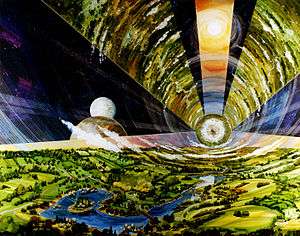Topopolis

A topopolis is a tube-like space habitat, rotating to produce artificial gravity via centrifugal force on the inner surface, which is extended into a loop around the local star. Topopoles can be looped several times around the local star, in a geometric figure known as a torus knot. The concept was invented by Pat Gunkel and mentioned by Larry Niven in the essay "Bigger Than Worlds" (1974). Topopoles are also called cosmic spaghetti.
A topopolis has been compared to an O'Neill cylinder extended in length so that it encircles a star.
A normal topopolis would be hundreds of millions of miles/kilometers long and at least several miles (kilometers) in diameter.
There is a somewhat well described example of a topopolis in the novel Matter by Iain M. Banks. This particular topopolis looped its system star many times in various braidings, housing trillions of sapient residents. The topopolis was so massive that stray gases from the system collected within the major spacing within the braids by gravitation alone, producing a slight atmosphere between the strands, described by the author as a "haze".